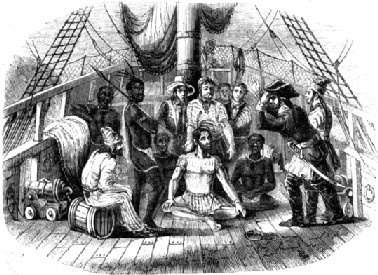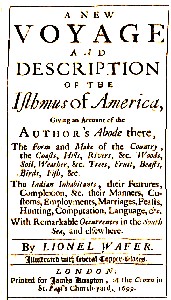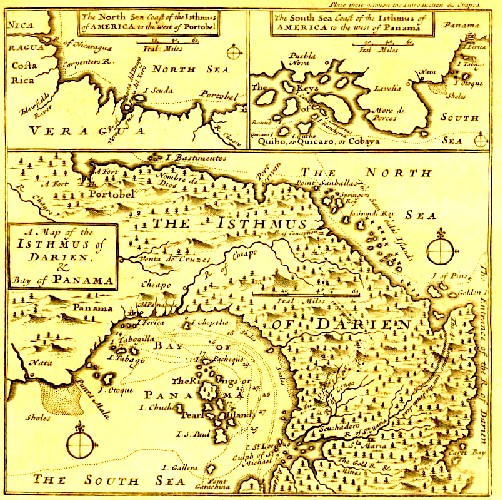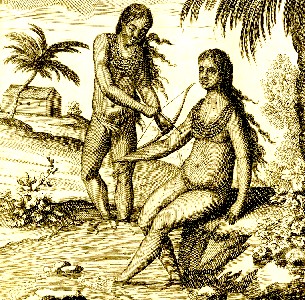
History of Pirate Surgeons Menu: 1 2 3 4 5 6 7 8 9 10 11 12 Next>>
The History of Sea and Pirate Surgeons, Page 5
Buccaneer Surgeon Lionel Wafer
Both Ringrose's and Dampier's books were good, serious travel books. By comparison Lionel Wafer's book was fun. Wafer seems to have a jolly time in his travels, joyously exercising his medical skills for the benefit of others and doing the sorts of silly things that make this pirate surgeon/writer proud.
Wafer was one of the few pirates we can point to who actually decided to get himself tattooed. (Despite the myth perpetuated by modern media, most historians have failed to find sufficient evidence that tattooing was a common practice among pirates. Don't believe everything you see on TV.) As he described it in his book, Wafer "was painted by their Women; but I would not suffer

Artist: Ebenezer Landes
Lionel Wafer Discovered Among the Indians (1845)
them to prick my Skin [as would be done for a permanent tattooing], to rub the Paint in, as they use to do, but only to lay it on in little specks."1 Wafer's reticence to get a permanent tattoo hints that such things were not widely accepted in the sea community at this time. In fact, he later tells us "I did what I could presently to wash off my Paint, but 'twas near a Month before I could get tolerably rid of it, having had my Skin so long stain'd with it, and the Pigment dried on in the Sun: And when it did come off, 'twas usually with the peeling off of Skin and all."2
His tattooing did lead to an amusing story when he later met up with his crew, however. Wafer explains it in his typical fashion: "I sat a while cringing upon my Hams among the Indians [who had tattooed him], after their Fashion, painted as they were, and all naked but only about the Waist, and with my Nose-piece… hanging over my Mouth. I was willing to try if they [the ship's crew] would know me in the Disguise; and 'twas the better part of an Hour before one of the Crew, looking more narrowly upon me, cry'd out, Here's our Doctor".3
Wafer tells us he first went seafaring in 1677 aboard the Great Ann of London which was bound for Bantam, Indonesia. He was "in the Service of the Surgeon of the Ship; but being then very young, I made no great Observations in that Voyage."4 (Presumably he is talking about failing to observe what happened on the voyage and not what the surgeon was trying to explain to him in his training. Although with Wafer, you never know.) Returning to London in 1679, he joined a voyage to the West Indies where he was "also in the Service of the Surgeon of the Ship"5 as a surgeon's assistant. Once in Jamaica he decided to stay there with his brother who worked for Sir Thomas Modyford, the former governor of the island since his "chief Inducement in undertaking this Voyage was to see him."6

Lionel Wafer's book (1699)
While in Jamaica, Wafer's brother "settled me in a House at Port-Royal, where I followed my Business of Surgery for some Months. But in a while I met with Capt. [Edward] Cook, and Capt. Linch [Lynch], two Privateers, who were going out from Port-Royal, toward the Coast of Cartagena, and took me along with them."7
It is interesting that Wafer chose to do this because the goal of many ship's surgeons was to land a more comfortable, better-paying land-based job. A land-based surgeon's revenue was dependant on their ability to attract patients, so it may have been that Wafer, being so young and inexperienced ( having completed only about 2-3 years of his seven year apprenticeship) may not have found his Jamaican practice lucrative. It may also have been that he simply craved adventure, which appears to be in agreement with his general nature. However, after tantalizing us with the fact of his curious change in career path, Wafer skips the explanation for it and simply continues telling what happened when he joined the buccaneers.
Although not specifically stated, he appears to have again served as a surgeon's assistant or a surgeon's mate when he started sailing with the buccaneers. This is suggested in his account of the buccaneers' disastrous attack on Arica, Chile. Wafer tells us "we lost a great number of our Men; and every one of our Surgeons was kill'd beside my Self, who was then left to guard the Canoas."8 While Wafer doesn't mention why the other surgeons were lost, Ringrose explained, "they having been drinking [apparently at the Arica's hospital] while we assaulted the fort and thus would not come with us when they were called."9
Wafer thus appears to have received an instant promotion, being the most senior surgeon remaining among the crew. This was not entirely uncommon; many surgeon's mates or assistants received fast field promotions despite their incomplete training. Writing in 1720, Josiah Burchett tells us "'many of the Chirurgeons, but more especially their Mates…are not altogether so well Qualify'd as they ought to be.'"10 Nevertheless, they were better than the alternative.
Most of Wafer's book deals with the privateers crossing the Isthmus

Lionel Wafer's Map of the Isthmus of Darien and Bay of Panama (1699)
and his time among the Kuna Indians who lived there. William Dampier and his crew had to "return back over the Isthmus, or go to seek their Fortune other-ways" after they decided to split from the other buccaneers on the Pacific side of the isthmus.11 The hike required the buccaneers to fjord several rivers. Following one such crossing Wafer tells us that he "was sitting on the Ground near one of our Men, who was drying of Gunpowder in a Silver Plate: But not managing it as he should, it blew up, and scorch'd my Knee to that degree, that the Bone was left bare, the Flesh being torn away, and my Thigh burnt for a great way above it."12
He did his best to keep up with the rest of the crew, but finally had to stop because of his wound. This is how he and four other men came to be staying with the Kuna Indians. Wafer tells us that he had "no means to alleviate the Anguish of my Wound, [so] the Indians undertook to cure me; and apply'd to my Knee some Herbs, which they first chew'd in their Mouths to the consistency of a Paste, and putting it on a Plantain-Leaf, laid it upon the Sore. This prov'd so effectual, that in about 20 Days use of this Poultess [poultice], which they applied fresh every Day, I was perfectly cured".13
Wafer was later able to return the favor, by assisting in the healing of one of Kuna

Indian Method of Bleeding from Wafer's book (1699)
Indian Chief Lacenta's wives. She "was to be let Blood; which the Indians perform in this manner: The Patient is seated on a Stone in the River, and one with a small Bow shoots little Arrows into the naked Body of the Patient, up and down; shooting them as fast as he can, and not missing any part. But the Arrows are gaged, so that they penetrate no farther than we generally thrust our Lancets: And if by chance they hit a Vein... and the Blood spurts out a little, they will leap and skip about, shewing many Antick Gestures, by way of rejoycing and triumph."14
Wafer offered to show the chief a better way to let blood. The chief agreed so Wafer "bound up her Arm with a piece of Bark, and with my Lancet breathed a Vein."15 The chief was shocked by the way the blood streamed out, threatened Wafer with his lance, "and swore by his Tooth, that if she did otherwise than well, he would have my Heart's Blood."16 Wafer advised the chief to be patient. He then "drew off about 12 Ounces, and bound up her Arm, and desired she might rest till the next Day: By which means the Fever abated, and she had not another Fit."17
This made Wafer quite popular with the Kunas. He tells us he "was taken up into a Hammock, and carried on Men's Shoulders, Lacenta himself making a Speech in my Praise, and commending me as much Superiour to any of their Doctors. Thus I was carried from Plantation to Plantation, and lived in great Splendor and Repute, administring both Physick [medicine] and Phlebotomy [bloodletting] to those that wanted."18 A fascinating character, indeed.
1Lionel Wafer, A New Voyage and Description of the Isthmus of Darien, p. 58; 2Ibid, p. 64-5; 3Ibid, p. 64; 4Ibid, p. 33; 5Ibid, p. 34; 6Ibid, p. 35; 7Ibid; 8Ibid, p. 186; 9Alexandre Exquemelin [Basil Ringrose], The History of the Buccaneers of America, p. 412; 10Harold J. Cook, "Practical Medicine and the British Armed Forces After the 'Glorious Revolution'," Medical History, 1990, p. 15; 11Dampier, p. 9; 12Wafer, p. 36; 13Ibid., p. 38-9; 14Ibid., p. 54; 15Ibid., p. 54-5; 16Ibid., p. 55; 17Ibid.; 18Ibid.;

